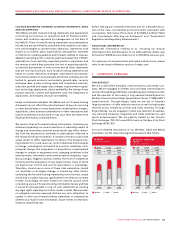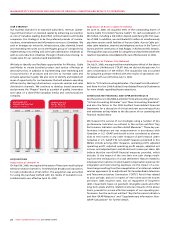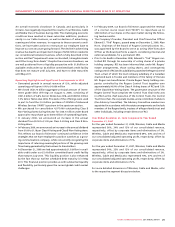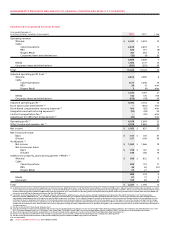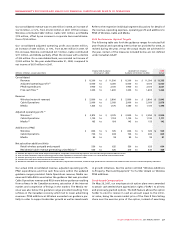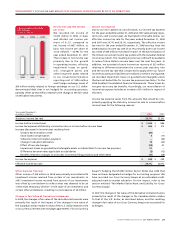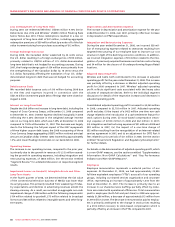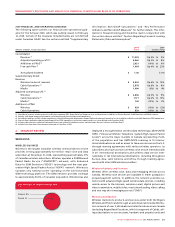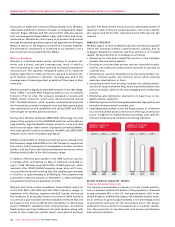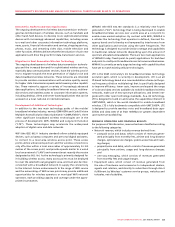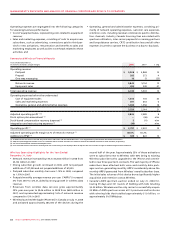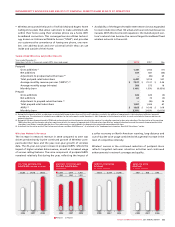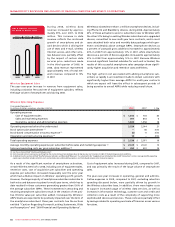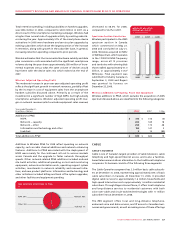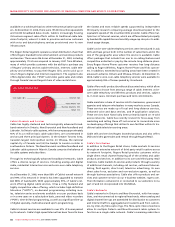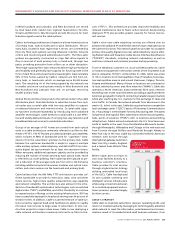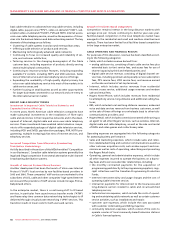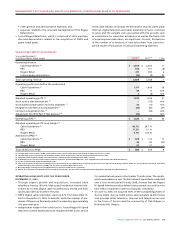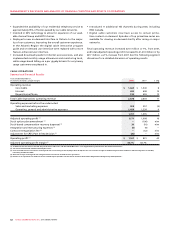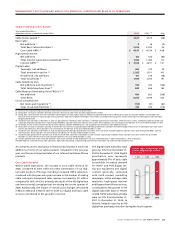Rogers 2008 Annual Report Download - page 37
Download and view the complete annual report
Please find page 37 of the 2008 Rogers annual report below. You can navigate through the pages in the report by either clicking on the pages listed below, or by using the keyword search tool below to find specific information within the annual report.
ROGERS COMMUNICATIONS INC. 2008 ANNUAL REPORT 33
MANAGEMENT’S DISCUSSION AND ANALYSIS OF FINANCIAL CONDITION AND RESULTS OF OPERATIONS
Demand for Sophisticated Data Applications
The ongoing development of wireless data transmission technolo-
gies has led developers of wireless devices, such as handsets and
other hand-held devices, to develop more sophisticated wireless
devices with increasingly advanced capabilities, including access
to e-mail and other corporate information technology platforms,
news, sports, financial information and services, shopping services,
photos, music, and streaming video clips, mobile television and
other functions. Wireless believes that the introduction of such new
applications will drive the growth for data transmission services.
Migration to Next Generation Wireless Technology
The ongoing development of wireless data transmission technolo-
gies and the increased demand for sophisticated wireless services,
especially data communications services, have led wireless provid-
ers to migrate towards the next generation of digital voice and
data broadband wireless networks. These networks are intended
to provide wireless communications with wireline quality sound,
far higher data transmission speeds and streaming video capabili-
ties. These networks support a variety of increasingly advanced
data applications, including broadband Internet access, multime-
dia services and seamless access to corporate information systems,
including desktop, client and server-based applications that can be
accessed on a local, national or international basis.
Development of Additional Technologies
In addition to the two main technology paths of the mobile/
broadband wireless industry, namely GSM/HSPA and Code Division
Multiple Access/Evolution Data Optimized (“CDMA/EVDO”), three
other significant broadband wireless technologies are in the
process of development: WiFi, WiMAX and Long-term Evolution
(“LTE”). These technologies may accelerate the widespread
adoption of digital voice and data networks.
WiFi (the IEEE 802.11 industry standard) allows suitably equipped
devices, such as laptop computers and personal digital assistants,
to connect to a local area wireless access point. These access
points utilize unlicenced spectrum and the wireless connection is
only effective within a local area radius of approximately 50-100
metres of the access point, and provide speeds similar to a wired
local area network (“LAN”) environment (most recently the version
designated as 802.11n). As the technology is primarily designed for
in-building wireless access, many access points must be deployed
to cover the selected local geographic area, and must also be inter-
connected with a broadband network to supply the connectivity
to the Internet. Future enhancements to the range of WiFi service
and the networking of WiFi access points may provide additional
opportunities for wireless operators or municipal WiFi network
operators, each providing capacity and coverage under the appro-
priate circumstances.
WiMAX (the IEEE 802.16e standard) is a relatively new fourth
generation (“4G”) technology that is being developed to enable
broadband wireless services over a wide area at a cost point to
enable mass market adoption. By contrast with WiFi, WiMAX is
a cellular-like technology that operates in defined, licenced fre-
quency bands and is thereby not hampered by interference from
other applications and services using the same frequencies. The
technology is designed to provide similar coverage and capabilities
to traditional cellular networks (depending upon the amount of
spectrum allocated and available). There are two main applications
of WiMAX today: fixed (point-to-point) applications for backhaul
and point-to-multipoint broadband access to homes and businesses.
WiMAX is currently an early stage technology with capabilities that
have yet to match existing cellular technologies.
LTE is the GSM community’s 4G broadband wireless technology
evolution path, which is currently in development. LTE is an all
IP-based technology based on a new modulation scheme (orthogo-
nal frequency-division multiplexing) that is specifically designed
to improve efficiency, lower costs, improve and expand the range
of voice and data services available via mobile broadband wireless
networks, make use of new spectrum allocations, and better inte-
grate with other open technology standards. As a 4G technology,
LTE is designed to build on and evolve the capabilities inherent in
UMTS/HSPA, which is the world standard for mobile broadband
wireless. LTE is fully backwards compatible with UMTS/HSPA. LTE
is designed to provide seamless voice and broadband data capa-
bilities and data rates of at least 100Mbps (or greater, dependent
upon spectrum availability).
WIRELESS OPERATING AND FINANCIAL RESULTS
For purposes of this discussion, revenue has been classified according
to the following categories:
• Networkrevenue,whichincludesrevenuederivedfrom:
• postpaid(voiceanddata),whichconsistsofrevenuesgener-
ated principally from monthly fees, airtime and long-distance
charges, optional service charges, system access fees and roam-
ing charges;
• prepaid(voiceanddata),whichconsistsofrevenuesgenerated
principally from airtime, usage and long-distance charges;
and
• one-way messaging, which consists of revenues generated
from monthly fees and usage charges.
• Equipment sales, which consist of revenue generated from
the sale of hardware and accessories to independent dealers,
agents and retailers, and directly to subscribers through direct
fulfillment by Wireless’ customer service groups, websites and
telesales, net of subsidies.


